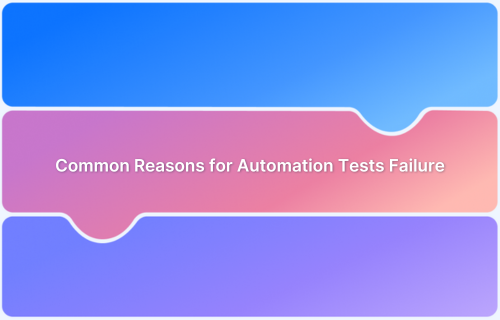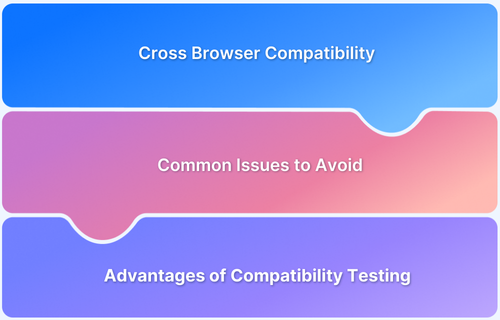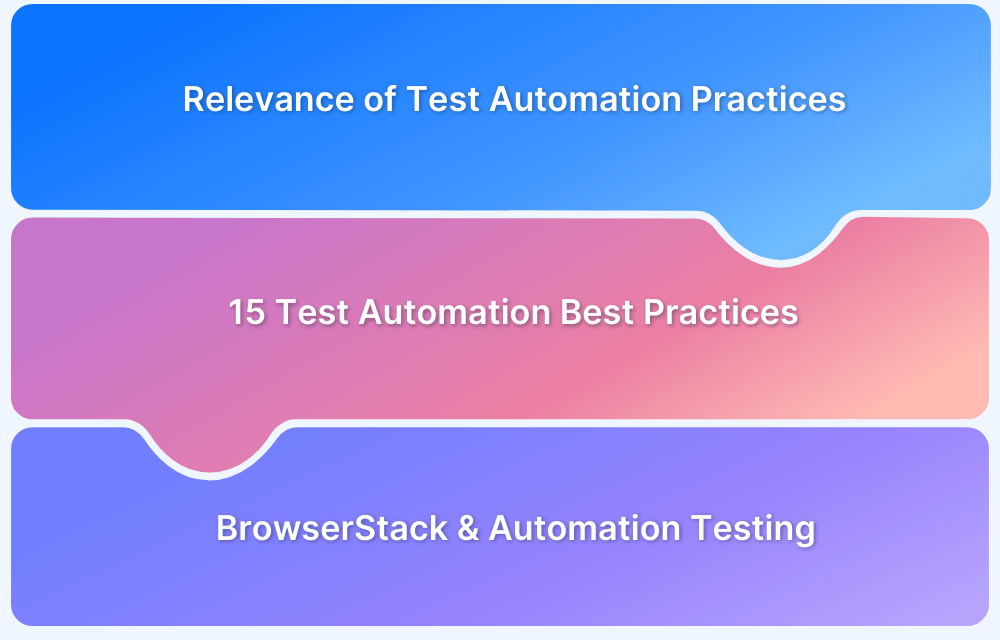Effective test automation requires a clear strategy and adherence to automation coding standards to ensure reliability, scalability, and maintainability. By following established best practices, teams can optimize their automation efforts and reduce long-term maintenance costs.
Overview
Test automation uses specialized tools and scripts to execute tests automatically, enhancing efficiency and accuracy over manual testing. It accelerates testing, increases coverage, and reduces human errors, enabling faster feedback, continuous testing, and multi-environment execution.
Best Practices for Test Automation:
- Focus on Documentation: Ensure clear documentation for test cases and frameworks.
- No Code Duplication: Reuse code components to avoid unnecessary repetition and improve maintainability.
- Keep It Simple: Write modular, atomic tests to maintain clarity and ease of updates.
- Automate for Immediate Needs: Focus on automating stable, high-priority tests first.
- Choose the Right Platform: Select automation tools and platforms that align with your project’s requirements.
- Regular Maintenance: Continuously refactor tests and remove obsolete or redundant scripts.
This article outlines key best practices for test automation, offering a comprehensive checklist to guide teams in building robust, high-quality automated test suites.
Importance of a Well-Defined Automation Strategy
A well-defined automation strategy is essential for maximizing the effectiveness of test automation efforts. It provides clear direction, aligns the automation process with business objectives, and ensures that resources are used efficiently.
- Aligns with Business Goals: A well-structured strategy ensures that automation efforts directly contribute to key business objectives, such as faster release cycles, better test coverage, and reduced manual testing costs.
- Optimizes Resource Allocation: With a clear strategy, teams can focus on automating the most critical and high-impact tests first, ensuring that resources like time, tools, and skillsets are used effectively for maximum return on investment.
- Improves Test Coverage and Reliability: A defined strategy helps ensure comprehensive test coverage across different platforms, browsers, and environments, which leads to more reliable and consistent test results while reducing the risk of undetected defects.
- Ensures Scalability and Long-Term Success: By planning for growth and future product changes, a solid automation strategy helps build a scalable framework that can easily adapt to new features, tools, and testing requirements without requiring costly rework.
- Fosters Collaboration and Consistency: A well-defined strategy establishes clear guidelines, promoting consistency in coding practices, test design, and tool selection, and encouraging better collaboration between developers, testers, and other stakeholders across the team.
A clear automation strategy lays the foundation for effective, scalable testing. To streamline this process, BrowserStack Automate enables automated testing on real devices and browsers, offering seamless cross-browser testing for web and mobile applications.
Best Practices for Test Automation
To ensure the success of your test automation efforts, it’s essential to follow best practices that optimize efficiency, maintainability, and scalability. Here are key practices to guide your approach:
1. Focus on documentation
Automation code is usually written, added and updated by multiple individuals to a version control system. In such an environment, proper documentation, comments and consistent naming conventions are of the utmost importance. It helps organize every developers’ code and helps their peers keep track of the entire code base. If one coder leaves the team or wants to add new functionality by using existing code, they can debug, update, test and analyze results with greater results.
2. No Code Duplication
Code duplication is one of the most common and harmful issues in test automation. Repeating logic across multiple test cases or modules leads to bloated codebases, increased maintenance effort, and a higher risk of inconsistencies.
When the same piece of code exists in multiple places, even a minor change can become time-consuming and error-prone.
This issue often arises when multiple test teams independently use similar code, as shown in the following example:
[TestMethod]
[Description("Validate that user is able to fill out the form successfully using valid data.")]
public void Test1()
{
Driver = GetChromeDriver();
SampleAppPage = new SampleApplicationPage(Driver);
TheTestUser = new TestUser();
TheTestUser.FirstName = "Nikolay";
TheTestUser.LastName = "BLahzah";
EmergencyContactUser = new TestUser();
EmergencyContactUser.FirstName = "Emergency First Name";
EmergencyContactUser.LastName = "Emergency Last Name";
SetGenderTypes(Gender.Female, Gender.Female);
SampleAppPage.GoTo();
SampleAppPage.FillOutEmergencyContactForm(EmergencyContactUser);
var ultimateQAHomePage = SampleAppPage.FillOutPrimaryContactFormAndSubmit(TheTestUser);
AssertPageVisible(ultimateQAHomePage);
}
[TestMethod]
[Description("Fake 2nd test.")]
public void PretendTestNumber2()
{
Driver = GetChromeDriver();
SampleAppPage = new SampleApplicationPage(Driver);
TheTestUser = new TestUser();
TheTestUser.FirstName = "Nikolay";
TheTestUser.LastName = "BLahzah";
EmergencyContactUser = new TestUser();
EmergencyContactUser.FirstName = "Emergency First Name";
EmergencyContactUser.LastName = "Emergency Last Name";
SampleAppPage.GoTo();
SampleAppPage.FillOutEmergencyContactForm(EmergencyContactUser);
var ultimateQAHomePage = SampleAppPage.FillOutPrimaryContactFormAndSubmit(TheTestUser);
AssertPageVisibleVariation2(ultimateQAHomePage);
}The code above includes multiple instances of duplication. Now, if variable changes, such as the name of the class representing the SampleApplicationPage, or even how each of the TestUser objects is initialized, complications will arise. In this example, the tester will have to update code in two places for every change. That means twice the work and twice the possibility of making a mistake.
An easy way to resolve this is to wrap the common lines of code in a method. In the example, since these are steps for setup, one can tag the method with a [TestInitialize] attribute. Additionally, let the testing framework call the method before every [TestMethod].
Here’s the reworked code:
[TestInitialize]
public void SetupForEverySingleTestMethod()
{
Driver = GetChromeDriver();
SampleAppPage = new SampleApplicationPage(Driver);
TheTestUser = new TestUser();
TheTestUser.FirstName = "Nikolay";
TheTestUser.LastName = "BLahzah";
EmergencyContactUser = new TestUser();
EmergencyContactUser.FirstName = "Emergency First Name";
EmergencyContactUser.LastName = "Emergency Last Name";
}
Now have a look at the improved code, in which the method is called before every test is run:
[TestMethod]
[Description("Validate that user is able to fill out the form successfully using valid data.")]
public void Test1()
{
SetGenderTypes(Gender.Female, Gender.Female);
SampleAppPage.GoTo();
SampleAppPage.FillOutEmergencyContactForm(EmergencyContactUser);
var ultimateQAHomePage = SampleAppPage.FillOutPrimaryContactFormAndSubmit(TheTestUser);
AssertPageVisible(ultimateQAHomePage);
}
[TestMethod]
[Description("Fake 2nd test.")]
public void PretendTestNumber2()
{
SampleAppPage.GoTo();
SampleAppPage.FillOutEmergencyContactForm(EmergencyContactUser);
var ultimateQAHomePage = SampleAppPage.FillOutPrimaryContactFormAndSubmit(TheTestUser);
AssertPageVisibleVariation2(ultimateQAHomePage);
}
As one can see, the improved code is shorter in length and cleaner due to the absence of duplicate code.
Removing duplication is instrumental to the success of code automation. Always analyze every bit of code for signs of duplication, and do everything possible, so that the code is cleaned up from this aspect.
3. Keep It Simple
It is common for programmers to continue adding code on a class or function level without having clarity on what the class or function is supposed to do in the first place. If anyone is writing two hundred lines of code at the function level, they should be worried. At this point, code clarity and quality will inevitably be compromised. Again, if a class contains twenty methods or so, it does not serve one purpose. At this point, it needs to be fragmented into smaller classes. If necessary, classes need to be consolidated within different packages.
Keep the Single Responsibility Principle in mind when writing code. The principle states that each class, function or module must carry responsibility over only a single part of software functionality. This means that if a certain functionality has to be tested, the tester knows exactly which packages, modules, functions and classes will be impacted.
4. Code only for Immediate Requirements
A common issue in test automation is overengineering, where code is written to accommodate possible future scenarios that may never occur. Although intended to make the test suite future-ready, this practice often leads to unnecessary complexity and maintenance challenges.
Overengineering can take several forms. A typical example is when a test engineer builds out an entire page object, adding locators and methods for every element on the page, even if only a few are required for the current test. This results in large classes that contain little immediately usable logic, making it harder for other team members to navigate and maintain the code.
The solution is to write automation code that addresses clearly defined and current requirements. For example, if a test case needs to verify that a method returns a specific value, the code should focus only on that validation. Avoid introducing logic for scenarios that are not yet needed or specified.
By limiting code to present needs, teams can keep their automation frameworks clean, readable, and easier to maintain and extend when actual requirements change.
5. Find the Right Automation Platform
Choosing the right automation platform is essential to building a robust, scalable, and maintainable testing framework. The ideal platform should support the technologies your team uses, scale with your testing needs, and offer reliable execution across different environments.
Look for features such as compatibility with popular frameworks, support for parallel test execution, detailed reporting, and the ability to run tests on real devices and browsers. A platform that integrates well with your CI/CD pipeline can also help maintain fast release cycles without compromising test reliability.
For web testing, BrowserStack Automate provides access to over 3,500+ real devices and browsers, allowing teams to run automated tests across a wide range of environments. It works seamlessly with frameworks like Selenium, Cypress, Playwright, and Puppeteer.
For mobile app testing, BrowserStack App Automate offers reliable execution on real Android and iOS devices. It integrates smoothly with Appium, Espresso, and XCUITest, helping teams ensure app quality across real user conditions.
6. Follow Automation Coding Standards
Adhering to automation coding standards ensures clear, maintainable, and scalable test scripts. It establishes consistency in naming, structure, and error handling, making the code easier to read and collaborate on.
This reduces technical debt, improves reusability, and simplifies maintenance, resulting in faster bug detection and more reliable automated tests. Following these standards also enables smoother integration with other tools and frameworks, enhancing overall test efficiency and accuracy.
Read More: AI Automation and Testing
7. Integrate Tests into CI/CD Pipelines
Test automation delivers the most value when integrated into CI/CD pipelines. This allows tests to run automatically with every code change, ensuring immediate feedback and reducing the risk of regressions.
Integrating tests early in the pipeline supports continuous testing, enables faster releases, and ensures higher code quality with every deployment.
8. Manage Test Data Properly
Test data plays a critical role in producing reliable test results. Poor data management can lead to flaky or inconsistent outcomes. It’s essential to isolate test environments, use dynamic data where appropriate, and clean up test data post-execution.
Leveraging tools like BrowserStack Test Management can streamline this process. It provides a centralized platform for organizing test cases, integrating seamlessly with CI/CD pipelines, and automating test executions. This ensures that test data is managed efficiently, leading to more reliable and maintainable test suites.
Read More: Top 15 Test Data Management Tools
9. Ensure Proper Logging and Reporting
Clear logging and detailed reporting help identify failures quickly and reduce debugging time. Implement structured logs that capture meaningful information like test steps, input values, and error messages.
Choose a reporting tool or framework that highlights pass/fail trends, execution time, and skipped tests. This gives stakeholders full visibility into automation outcomes.
10. Handle Flaky Tests Immediately
Flaky tests fail intermittently without code changes, reducing the reliability of the test suite. Common causes include timing issues, unstable environments, or unreliable test data. To address flaky tests, identify and isolate them, analyze the root causes, and implement fixes such as adding waits, ensuring proper configuration, or using stable test data.
Resolving flaky tests promptly is crucial to maintain the effectiveness of the testing process and prevent deployment delays.
11. Prioritize Maintainability
An automation suite is only as good as its ability to adapt to change. Maintainability involves writing modular, reusable, and well-documented code. Avoid hardcoding values, use centralized configurations, and regularly review tests for relevance.
A maintainable test suite reduces long-term costs, supports faster updates, and scales smoothly with evolving requirements.
Why Choose BrowserStack for Test Automation?
BrowserStack Automate offers a comprehensive solution for scaling your test automation efforts efficiently. With access to a wide range of real devices and browsers, teams can run automated tests across a diverse set of environments without relying on emulators or simulators. This ensures more accurate and reliable results, simulating real-world usage.
Key features of BrowserStack Automate include:
- Real Device Testing: Run tests on actual devices, offering a more realistic simulation of user interactions than emulators or simulators.
- Seamless Integrations: Easily integrate with popular frameworks like Selenium, Appium, Cypress, Playwright, and Puppeteer, allowing teams to reuse their existing test scripts and workflows.
- Scalability: Leverage parallel test execution to significantly reduce testing time and accelerate delivery cycles, enabling faster feedback and more frequent releases.
- Reliable and Secure: With enterprise-grade security, BrowserStack ensures that your tests are executed in a secure environment, eliminating maintenance concerns associated with on-premise infrastructure.
By leveraging BrowserStack Automate, teams can scale their test automation, ensuring consistent test coverage and quicker releases while maintaining high-quality standards across both web and mobile applications.
Conclusion
Implementing best practices for test automation is crucial for achieving reliable, scalable, and efficient testing processes. By focusing on documentation, avoiding code duplication, simplifying tests, and adhering to automation coding standards, teams can create a robust automation suite that is easy to maintain and scale.
Additionally, integrating tests into CI/CD pipelines and managing test data effectively ensures faster feedback and higher test accuracy.
Choosing the right automation platform is essential to support these practices. With BrowserStack Automate, teams can execute automated tests across a wide range of real devices and browsers, integrate seamlessly with popular frameworks, and scale their testing efforts to match the pace of development.
By following these best practices and leveraging the power of BrowserStack, teams can deliver high-quality software faster while maintaining trust in their automation process.






